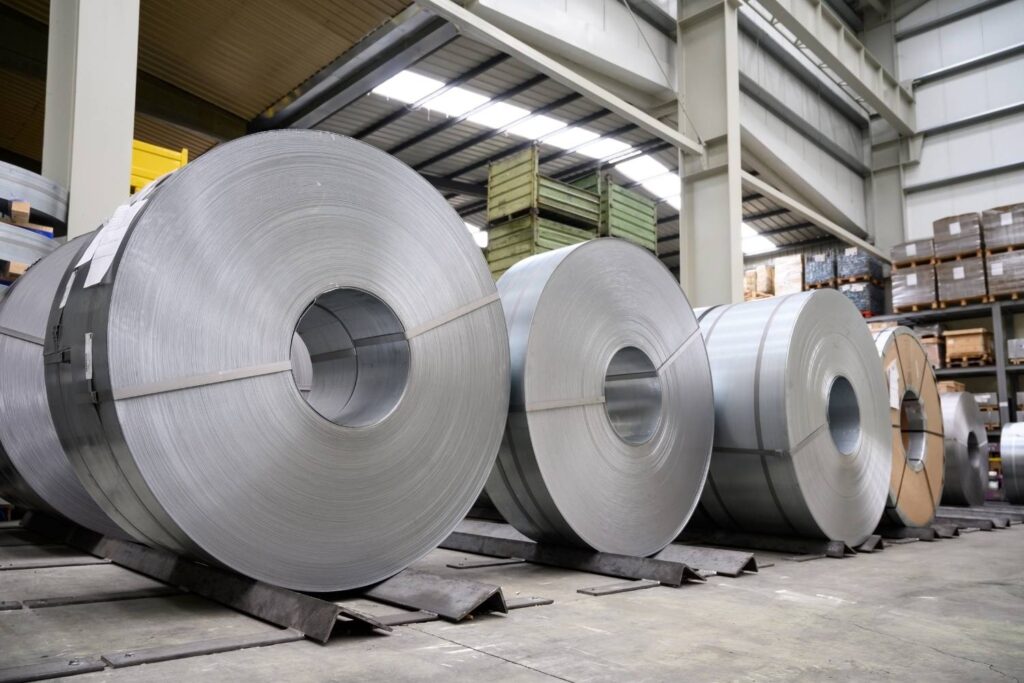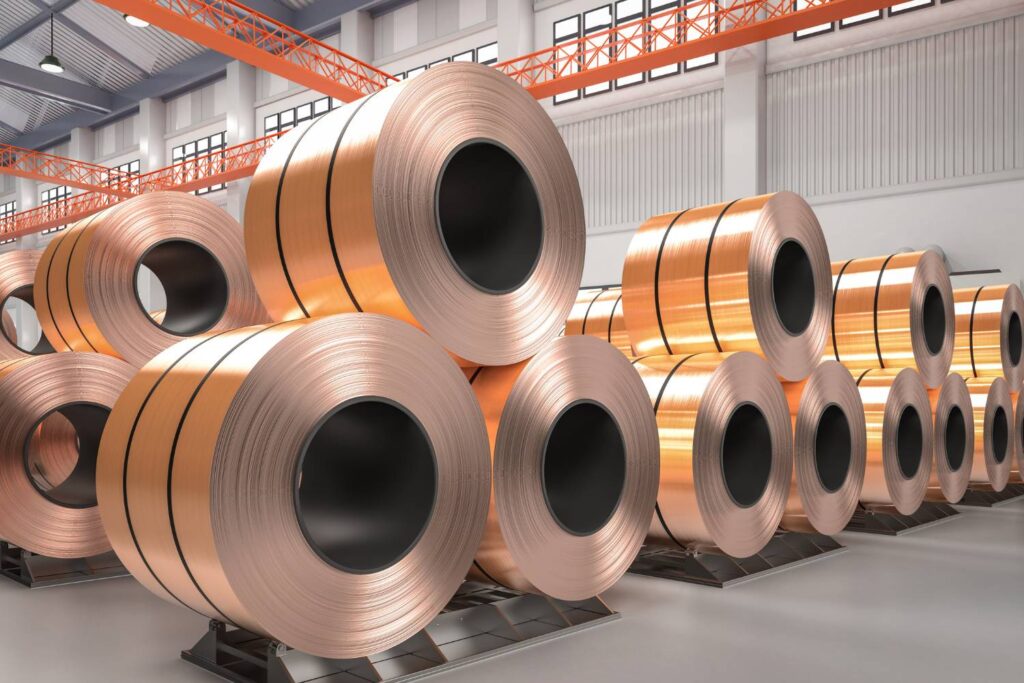Metal rolling is an essential process in the field of metal manufacturing, playing a critical role in shaping the modern industrial landscape.
From the sleek chassis of our cars to the robust beams supporting towering buildings, metal rolling is fundamental in creating numerous products we use daily.
Let’s get straight to the point
Metal rolling is a crucial metalworking process that shapes numerous everyday products, from car bodies to building beams. It involves passing metal through rolls to reduce thickness and improve mechanical properties.
There are two primary methods: hot rolling, ideal for large structural components, and cold rolling, which offers precision for items like automotive parts.
The process is efficient, enhances material strength, and is key to mass production. As the industry advances, metal rolling is becoming more sustainable and automated, ensuring its continued impact on modern manufacturing and product quality.

The Technique Behind Metal Rolling
Understanding the Metal Rolling Process
Metal rolling is a fundamental metalworking process that involves passing metal stock through one or more pairs of rolls. This process is designed to reduce thickness, ensure uniformity, and impart desired mechanical properties to the metal.
The versatility of metal rolling makes it indispensable in producing everything from thin, precise sheets to robust structural beams.
Hot Rolling vs. Cold Rolling
Metal rolling can be categorised based on the temperature at which it is performed:
- Hot Rolling: This process occurs above the metal’s recrystallisation temperature, allowing for easier deformation and shaping of large metal volumes. Hot rolling is primarily used in constructing the framework of our physical world, including I-beams and rail tracks.
- Cold Rolling: Performed below the metal’s recrystallisation temperature, cold rolling offers enhanced strength, surface finish, and tighter tolerances. These attributes are crucial for industries like automotive, appliance manufacturing, and electronics.
The Evolution of Metal Rolling
The evolution of metal rolling mirrors the advancement of civilisation itself. Originating as early as 600 BCE in the Middle East and South Asia, the process has undergone significant innovations.
From the rudimentary slitting mills of the 16th century to today’s sophisticated rolling mills, metal rolling has continually adapted to meet the demands of modern manufacturing.
Hot and Cold Rolling: A Comparative Look
The choice between hot and cold rolling depends on the desired material properties and application:
- Hot Rolling is ideal for producing large quantities of structural components where precise dimensions or surface imperfections are less critical.
- Cold Rolling caters to applications requiring precision, such as manufacturing vehicle bodies or electrical appliances, where surface finish and dimensional accuracy are paramount.
Rolling Techniques and Their Applications
Flat Rolling
Flat Rolling is the most basic form of metal rolling, primarily used for reducing metal thickness to produce plates or sheets. This technique is essential in creating various everyday products, from car body panels to kitchen appliances.
Thread and Gear Rolling
Thread and Gear Rolling employs specialised dies to create high-strength threads or gears with minimal material waste. This technique is vital in producing precise components for machinery and automotive industries.
Shape Rolling
Shape Rolling is used to produce predefined shapes, such as I-beams or rails, crucial for the construction industry. This technique ensures that these structural elements meet the stringent demands of modern building standards.
Ring Rolling
Ring Rolling is a specialised process that increases the diameter of rings used in manufacturing bearings, turbines, and aerospace components. This technique is essential for producing components that can withstand extreme conditions and stresses.
The Advantages of Metal Rolling
Speed and Efficiency
One of the key advantages of metal rolling is its speed and efficiency. The process allows for the production of large volumes of material quickly, ensuring consistent quality across products. This efficiency is pivotal in achieving mass production with high design flexibility, significantly reducing costs compared to traditional manufacturing methods like casting and forging.
Enhanced Mechanical Properties
Metal rolling improves the mechanical properties of the rolled material, such as grain structure and strength. This enhancement is crucial for products that require high durability and reliability, like automotive parts and construction materials.
Versatility in Manufacturing
The adaptability of metal rolling to different techniques makes it suitable for a wide range of manufacturing needs. Whether producing intricate mechanical components or foundational infrastructure elements, metal rolling proves to be an indispensable process in various industries.
The Future of Metal Rolling
Advancements in Sustainability
As the metal fabrication industry evolves, so does the technique of metal rolling. Recent advancements aim to increase the sustainability and environmental efficiency of rolling processes. This includes efforts to reduce energy consumption, minimise material waste, and develop greener manufacturing practices.
Integration of Automation and Digital Technologies
The future of metal rolling is poised to integrate automation and digital technologies further. These advancements will enhance precision, efficiency, and the ability to produce even more complex and high-quality metal products. As a result, metal rolling will continue to play a pivotal role in modern manufacturing.
Applications of Metal Rolling in Everyday Life
Metal rolling significantly influences various industries, shaping the products we rely on daily. Here’s a closer look at how this process impacts our world.
Infrastructure and Construction
One of the most visible applications of metal rolling is in the construction and infrastructure sector. Metal rolling is instrumental in creating metal roofing, wall panels, guardrails, and signposts. These roll-formed products offer durability, energy efficiency, and ease of installation in various colours and finishes.
Transportation: Automobiles and Trains
The automotive and railway industries heavily depend on metal rolling for both structural and aesthetic components. Vehicles and train cars are constructed using parts like exterior panels, protective steel sill plates, and decorative stainless steel rails. All made possible through metal rolling.
Data Centers
The digital age has expanded metal rolling’s role in the tech sector, particularly in constructing data centres. Server racks, vital for housing digital information, are constructed using roll-formed parts. The process’s ability to manipulate materials like galvanised stainless steel into complex shapes makes it ideal for creating these critical components.
Warehousing
Metal rolling contributes significantly to warehouse functionality. Shelving units, supports, cross members, and automated pallet rails are all metal rolling products. These components ensure warehouses operate efficiently and facilitate storage and logistics operations.
Aerospace and Military
In aerospace, metal rolling is used to create the exteriors of aeroplanes and undercarriage compartments for luggage storage. Similarly, metal rolling is vital in the military sector in producing armoured vehicles, including tanks. The process’s ability to manipulate thick materials like armoured steel is crucial in these high-stakes applications.
Consumer Products
Beyond industrial applications, metal rolling is integral to producing consumer products ranging from household appliances to electronics and furniture. The process’s ability to quickly and efficiently produce intricate and precise parts underscores its importance in everyday life.
Environmental Sustainability in Metal Rolling
Minimising Waste and Energy Consumption
An often overlooked aspect of metal rolling is its contribution to environmental sustainability. The process minimises waste by producing parts with high accuracy and consistency, reducing the need for excess materials and energy. This makes metal rolling a cornerstone of manufacturing and a more environmentally friendly and sustainable process.
Advancements in Green Manufacturing
Recent advancements in green manufacturing practices within metal rolling include the development of energy-efficient motor drives, optimised lubrication systems, and heat capture technologies. These innovations lower operational costs and contribute to environmental conservation, aligning with global efforts to combat climate change.
Metal Rolling Impact on Product Quality and Efficiency
Ensuring Product Quality Through Precision
Precision in metal rolling is paramount, directly impacting the final product’s quality. Industries such as automotive and aerospace, where safety is non-negotiable, depend on the accuracy of metal rolling to produce components that adhere strictly to safety standards. This precision guarantees that parts function flawlessly, contributing to the overall reliability of the vehicles and machinery in which they are used.
The Efficiency Advantage
One of the most compelling benefits of precise metal rolling is its efficiency in production processes. By utilising high-quality machines capable of consistent results, manufacturers can produce high-quality products much faster than with other metal forming methods. This not only accelerates the time to market but also enhances profitability by speeding up revenue generation from new products.
Tackling Common Rolling Problems
Common challenges in metal rolling, such as cracks, peeling, pitting, sticking, and even roller breakage, underscore the need for meticulous quality control and experienced operation. These issues, largely caused by excessive pressure, rapid temperature changes, or debris intrusion, can severely compromise product quality and lead to costly wastage and reworks.
The Role of Experience and Equipment
The success of metal rolling hinges on the expertise of the operators and the quality of the machinery used. Experienced fabricators equipped with specialised, high-quality rolling equipment can navigate the complexities of metal properties, ensuring that each product is formed with precision and efficiency. This expertise is crucial for minimising errors, reducing the need for repairs, and ultimately saving time and resources.

The Impact of Metal Rolling on Business
Enhancing Market Competitiveness
For businesses, the implications of metal rolling extend far beyond the production floor. By producing consistently high-quality products, companies can command higher price points, enhancing their market competitiveness. Furthermore, the speed and efficiency of precise metal rolling processes translate into cost savings, making it a strategically wise investment for any business operating in industries reliant on metal components.
Cost Savings Through Efficiency
The efficiency gained from advanced metal rolling techniques can significantly reduce production costs. This not only boosts a company’s bottom line but also allows for reinvestment in further technological advancements, driving continued innovation and growth.
Advancements and Promising Directions in Metal Rolling
Innovations in Rolling Mills and Automation
Recent improvements in rolling mills have focused on enhancing efficiency, precision, and safety. The evolution of rolling mills into highly automated cyber-physical systems marks a significant leap forward. Modern mills have advanced gauge and shape measurement scanners, precision servo-electric motors, and sophisticated control systems.
Advanced Simulation and Design Tools
The application of finite element analysis (FEA) and thermo-mechanical modelling has revolutionised the design and optimisation of rolling processes. These software tools enable engineers to accurately predict rolling forces, temperature effects, and product characteristics, significantly reducing the need for physical trials.
Towards Greener Manufacturing
Sustainability has become a key focus in the advancement of rolling technology. Efforts to reduce energy consumption and minimise waste have led to the development of energy-efficient motor drives, optimised lubrication systems, and heat capture technologies.
Leveraging Big Data for Precision Rolling
The collection and analysis of vast datasets have become integral to modern rolling mills. Real-time data on product dimensions, equipment performance, and process variables are routinely analysed to identify patterns, predict deviations, and refine rolling processes.
Conclusion
Metal rolling is a critical process that shapes countless everyday products, from infrastructure components to consumer goods.
Its ability to produce high-quality materials efficiently and sustainably underscores its importance in modern manufacturing.
As technological advancements continue to refine this process, metal rolling will remain at the forefront of industrial innovation, driving the creation of products that shape our world.

